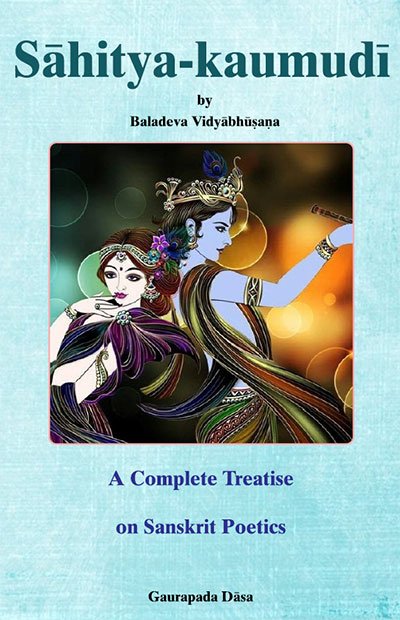Sahitya-kaumudi by Baladeva Vidyabhushana
by Gaurapada Dāsa | 2015 | 234,703 words
Baladeva Vidyabhusana’s Sahitya-kaumudi covers all aspects of poetical theory except the topic of dramaturgy. All the definitions of poetical concepts are taken from Mammata’s Kavya-prakasha, the most authoritative work on Sanskrit poetical rhetoric. Baladeva Vidyabhushana added the eleventh chapter, where he expounds additional ornaments from Visv...
Text 11.53
आनन्दयति श्यामां रसिकान् नयनानि च स्व-धामनि यः ।
विस्मापक-दामोदर-लीलो’वतु नः स गोविन्दः ॥
ānandayati śyāmāṃ rasikān nayanāni ca sva-dhāmani yaḥ |
vismāpaka-dāmodara-līlo’vatu naḥ sa govindaḥ ||
May Govinda protect us. In His abode, He delights Śyāmā, the rasikas, and the eyes (nayana). His pastimes as Dāmodara are astounding.
Commentary:
As an implied sense, Baladeva Vidyābhūṣaṇa eulogizes the line of his guru, Rādhā-Dāmodara Gosvāmī. The ascending order is: Rādhā-Dāmodara Gosvāmī, Nayanānanda Gosvāmī, Rasikānanda Murāri, Śyāmānanda Paṇḍita, [as well as Hṛdaya-caitanya Ṭhākura, Gaurīdāsa Paṇḍita, Caitanya Mahāprabhu, Īśvara Purī, Mādhavendra Purī, and so on up to Madhvācārya, Vyāsadeva, Nārada Muni, Brahmā, and Śrī Kṛṣṇa].
Furthermore, another noteworthy ornament is Jayadeva’s atyukti (hyperbole). He shows this example: “When you give in charity, O king of kings, beggars become wish-fulfilling trees!”[1] Most likely, Jayadeva reasons that in this example, the charm lies more in the exaggeration than in the contradiction (virodha).
This verse by Jīva Gosvāmī is another example:
bhogyānām uta bhogyānāṃ saṅkhyā saṅkhyā-vatām api |
saṅkhyānāya na kalpeta kalpe tatrāpayāty api ||“No one, not even the pandits, could count how many goodies there were on that occasion, even if the counting were to go on for a day of Brahmā” (Gopāla-campū 2.35.79).
The verse also features punar-uktavad-ābhāsa (semblance of a repetition) and yamaka (word rhyme).
The following verse is Paṇḍita-rāja Jagannātha’s example of the tiraskāra ornament (censure), which is the opposite of the anujñā ornament (11.49).
Jagannātha defines tiraskāra as a strong dislike for something well known as a quality, on account of a connection with a specific fault,[2]
śriyo me mā santu kṣaṇam api ca mādyad-gaja-ghaṭā-
mada-bhrāmyad-bhṛṅgāvali-madhura-saṃgīta-subhagāḥ |
nimagnānāṃ yāsu draviṇa-rasa-paryākula-hṛdāṃ
saparyā-saukaryaṃ hari-caraṇayor astam ayate ||“May I never have wealth, which is charming like mellifluous music when bees are hovering over the fluid on the temples of ruttish elephants,[3] because of those whose hearts are immersed in the enjoyment of luxury, the ease of obtainment of service to Hari’s feet is lost” (Rasa Gang).
